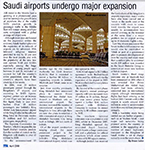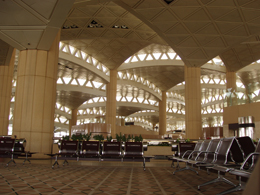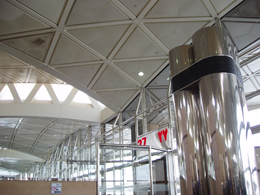Saudi Airports Undergo Major Expansion |
 |
<<Click to see original |
By anybody’s reckoning, air travel in the Middle East is growing at a phenomenal pace and one which far outstrips the growth rates of anywhere else in the world. {IATA predicts growth in passenger traffic in the Middle East will remain strong at 6.9 per cent, compared with a global average of 4.8 per cent.}

Although most eyes are focused on the expansion within the Emirates – most notably at the new Jebel Ali airport and at Abu Dhabi – Saudi Arabia’s plans for the expansion of its network of airports are far advanced.

The reasons are not hard to find. With inbound religious tourism predicted to rise by 20 per cent over the next decade, and with the popularity of the new low cost carriers – NAS and SAMA {– especially amongst the huge numbers of young people aged between 16 and 24, estimated to account for half the country’s entire population,} some of the country’s airports have been creaking at the seams.
In 2006, over 33 million passengers passed through the Kingdom’s 27 airports and according to IATA figures, regional carriers saw an increase of over 15 per cent last year, with this figure likely to soar even further. Over 15 million passengers use Jeddah’s King Abdul Aziz International airport while King Khaled in Riyadh and King Fahd in Dammam receive 11 million and 3.5 million passengers, respectively. The Supreme Commission for Tourism, which is responsible for Saudi Arabia’s tourism, predicts that the number of visitors to the Kingdom will double to over 45 million by 2020.
So the announcement 15 months ago by the General Authority for Civil Aviation (GACA) that it intended to invest a further SR30 billion in expanding airports in Jeddah, Madinah and Tabuk {(the Kingdom has so far spent more than SR60 billion on airports)} came as no surprise.
Just three months previously, {the Custodian of the Two Holy Mosques} King Abdullah had announced plans to convert Prince Muhammad ibn Abdul Aziz Airport in Madinah into an international airport, considering Madinah’s significant role in the Islamic world.
The decision increased the number of international airports in the Kingdom to four, {although there are now also plans to establish a fifth international airport at King Abdullah Economic City being built in Rabigh, 200 km north of Jeddah.}
Of all the airport construction surging ahead, the most prominent project is the expansion programme at Jeddah’s King Abdulaziz International Airport, which was first opened in 1981.
GACA had signed a SR5.6 billion agreement {with Bechtel-Saudi Arabia and Dar Al-Riyadh} for the expansion of the airport in 2003. Work started in the second quarter of 2004 and is scheduled for completion by the last quarter of 2010.
{The current project includes the construction of two new terminals, one for international and one for domestic passengers, and the extension of the existing Southern terminal for international and VIP use, with passageways connecting the terminals. The expansion will include gold-coloured crescent-shaped roofs, and internal gardens and walkways. In addition, there will be a new concourse with 25 passenger bridges, three connector buildings and an extensive upgrade of landside and airside infrastructure facilities. }
By the end of the current phase, the airport's annual passenger capacity will have increased from 13 million to 21 million, though last year Crown Prince Sultan signed a further SR903 million contract with Al-Mabani Company to increase its annual capacity to 80 million passengers by 2035. The Saudi authorities are keen to promote King Abdul Aziz as a serious future competitor for Dubai International as the region's main hub for cargo and passengers.
{According to GACA’s President, Abdullah Ruhaimy, the current work is designed to accommodate the new generation of large aircraft such as the A380, of which Emirates Airlines alone has already ordered 45.}
The southern terminal extension was completed in mid 2005, whilst in December 2007, King Abdullah opened the renovated Royal Terminal, which boasts a huge conference hall and a platform for official receptions which alone covers an area of 8,500 square metres.
Although Jeddah has received the lion’s share of the kingdom’s airports expansion, major works have also been carried out at Tabuk in the north west of the country with more to come. Until recently the airport was unable to accommodate two aircraft arriving in the terminal at the same time – a major problem for an airport serving up to 60 domestic flights a day. {But works over the past two years have increased the airport’s footprint by 12,000 square metres, offering new arrival and departure lounges and jet bridges linking the passengers from the gate to the plane. There are additional parking facilities for two large aircraft and three medium aircraft and car parking spaces for 900 vehicles at the expanded airport.}
Last May it was announced that Saudi Arabia’s fifth economic city would also be established in Tabuk as part of a government plan to promote development all over the country and create more than a million jobs. So a contract worth SR220 million was awarded to the Saudi Binladin Group to construct yet more new facilities at Tabuk airport.
Saudi Arabia’s third mega economic city at Madinah had been announced in 2006 when it was revealed that Prince Muhammad ibn Abdul Aziz Airport had been officially converted into an international airport, although international flights had been arriving as far back as 2000. Current work at this airport is worth around SR400 million in order to accommodate more than one million passengers annually, a major increase on the nine daily flights from certain Islamic countries, in addition to the internal Saudi Airlines flights that had been all it could previously cope with.
With a feasibility study being carried out on further airports – such as at Medain Salah – and major rail networks being planned across the country, in addition to the upgrading of a number of major highways, transport in the Kingdom of Saudi Arabia is set to change radically over the coming months and years ahead.
